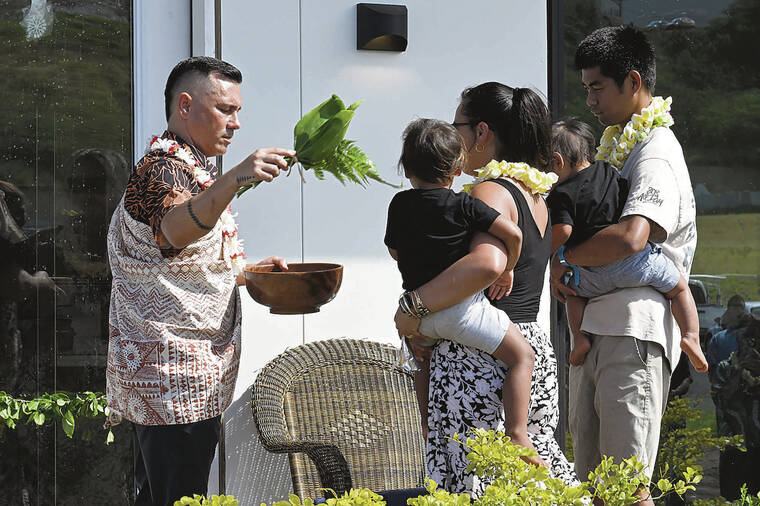HONOLULU — Gov. Josh Green, Maui Mayor Richard Bissen and other officials marked major milestones in providing more transitional housing for survivors of the Aug. 8, 2023, Maui wildfires.
At noon Tuesday, they celebrated the groundbreaking ceremony for Ka La‘i Ola, a new development for wildfire survivors, and later that afternoon, the handing of keys to the first family moving into a new housing project in Kahului.
Ka La‘i Ola is expected to provide 450 interim homes for wildfire survivors, who did not qualify for any type of federal aid.
“Ka La‘i Ola will house some of our most vulnerable population,” said Green during a news conference at the ceremony. “We have people that for one reason or another couldn’t qualify for homes or shelter. Maybe they weren’t here long enough; maybe they were just on the edge of where the fire occurred, but still couldn’t go home; maybe they had to go care for loved ones just months before and for some reason, once again didn’t qualify.”
He added, “We just said we have to make sure everyone gets a home above them — everyone.”
Another project, Ke Ao Maluhia at Maui Lani, is a collaborative effort among the state, county and others developed and managed by the Council for Native Hawaiian Advancement.
The nearly $9 million project on land owned by Maui County will offer 50 two-bedroom, modular homes to wildfire survivors by the end of July. The homes will be available for a monthly rent of $2,500, including water, sewer and trash collection.
An estimated 400 families are ineligible for assistance from FEMA, according to Green, and an estimated 765 displaced families remain in hotel rooms.
“We do intend to continue to make extensions, where necessary, to keep people housed,” he said.
The $115 million project — a partnership between the state and the nonprofit HomeAid Hawai‘i — will offer studios, one-, two- and three-bedroom units on 54 acres in the Leiali‘i area of West Maui for the next five years.
Ka La‘i Ola, named by Maui kumu hula Pueo Pata, means “The Place of Peaceful Recovery.”
Besides housing, it will offer comprehensive, on-site support services, including child care, health care and financial planning assistance, along with a “resiliency center” and playgrounds.
The application process for Ka La‘i Ola is expected to begin in early June, according to Joseph Campos, deputy director of the state Department of Human Services, with the first residents expected to be housed in August.
Green credited the speed of the development to the “unprecedented collaboration” among various state and county stakeholders, along with the contributions of various nonprofit partners.
“Everyone understood that if we did this together, we could rebuild 10 times faster, and that’s what we’re going to experience,” he said.
The state is contributing $75 million to the project, while the Hawai‘i Community Foundation is contributing $40 million to HomeAid Hawai‘i through its Maui Strong Fund.
The Hawai‘i Housing and Finance Development Corp. has leased the land for five years to the state Department of Human Services.
Afterward, the land and infrastructure will go to the state Department of Hawaiian Home Lands to provide homes for its beneficiaries.
FEMA, meanwhile, has secured a lease with HHFDC to develop 169 temporary modular units on 36 acres at the Kilohana group housing site nearby.
Bissen called Ka La‘i Ola a “huge step forward” heading into the ninth month of recovery efforts since the wildfires.
“This brings not only homes, but a renewed sense of hope and spirit in our healing here on the west side of Maui,” he said.
Maui County, meanwhile, remains focused on securing long-term housing options, clearing up debris and providing mental health support and resources to its residents, he said.
On Tuesday afternoon, officials joined the Council for Native Hawaiian Advancement to present a displaced family of four with the keys to their home at Ke Ao Maluhia at Maui Lani for the next five years.
The keys were blessed and presented to mom Josephine Frasier, father Kdin Dias, their two children, ages 1 and 3, who will move in, along with their dog, Keao.
The family has moved from place to place for months since being displaced by the wildfires.
The project is described as a collaborative effort among the state, Maui County, CNHA, Hawai‘i Community Foundation, FEMA and American Red Cross to provide homes to wildfire survivors for five years.
The first phase of the project is expected to be completed in June, with 34 homes, followed by another 16 homes to be finished in July.
More families will be provided homes in upcoming weeks, according to Kuhio Lewis, CEO of CNHA. To apply, residents must be verified to have been affected by the Maui wildfires.
The Hawai‘i Regional Council of Carpenters provided labor for the project, while the Convoy for Hope donated furniture for the units.
Both projects are part of the Maui Interim Housing Plan, which outlines a phased approach to delivering housing while prioritizing options that produce permanent housing.
“Today marks the strength of partnerships and is a testament to what can be achieved when government, the private sector, nonprofit organizations and the community work together,” Lewis said.
“Delivering the first home at Ke Ao Maluhia through the Maui Interim Housing Plan is a significant milestone for families and a clear indication of our collective commitment to addressing Maui’s housing crisis.”


